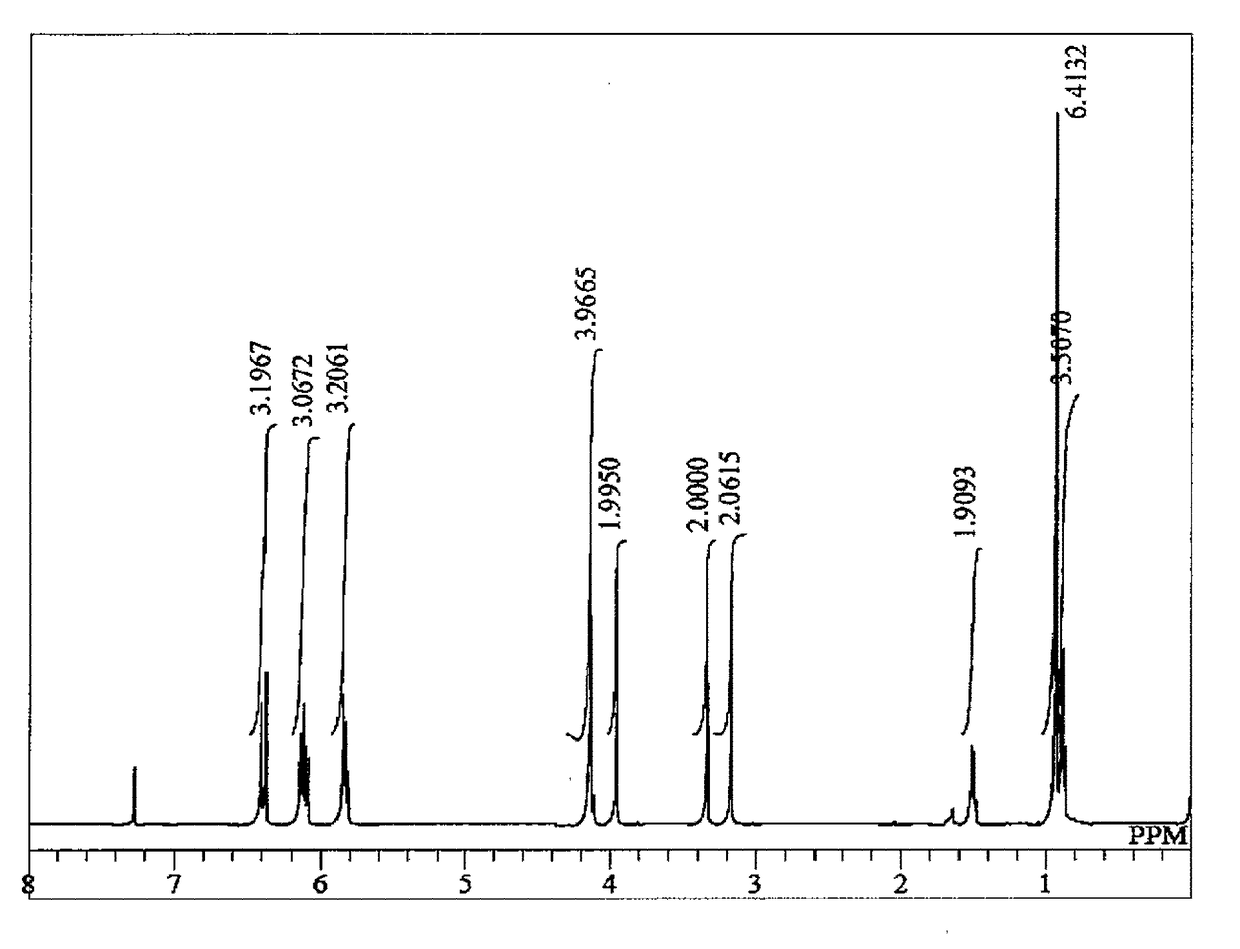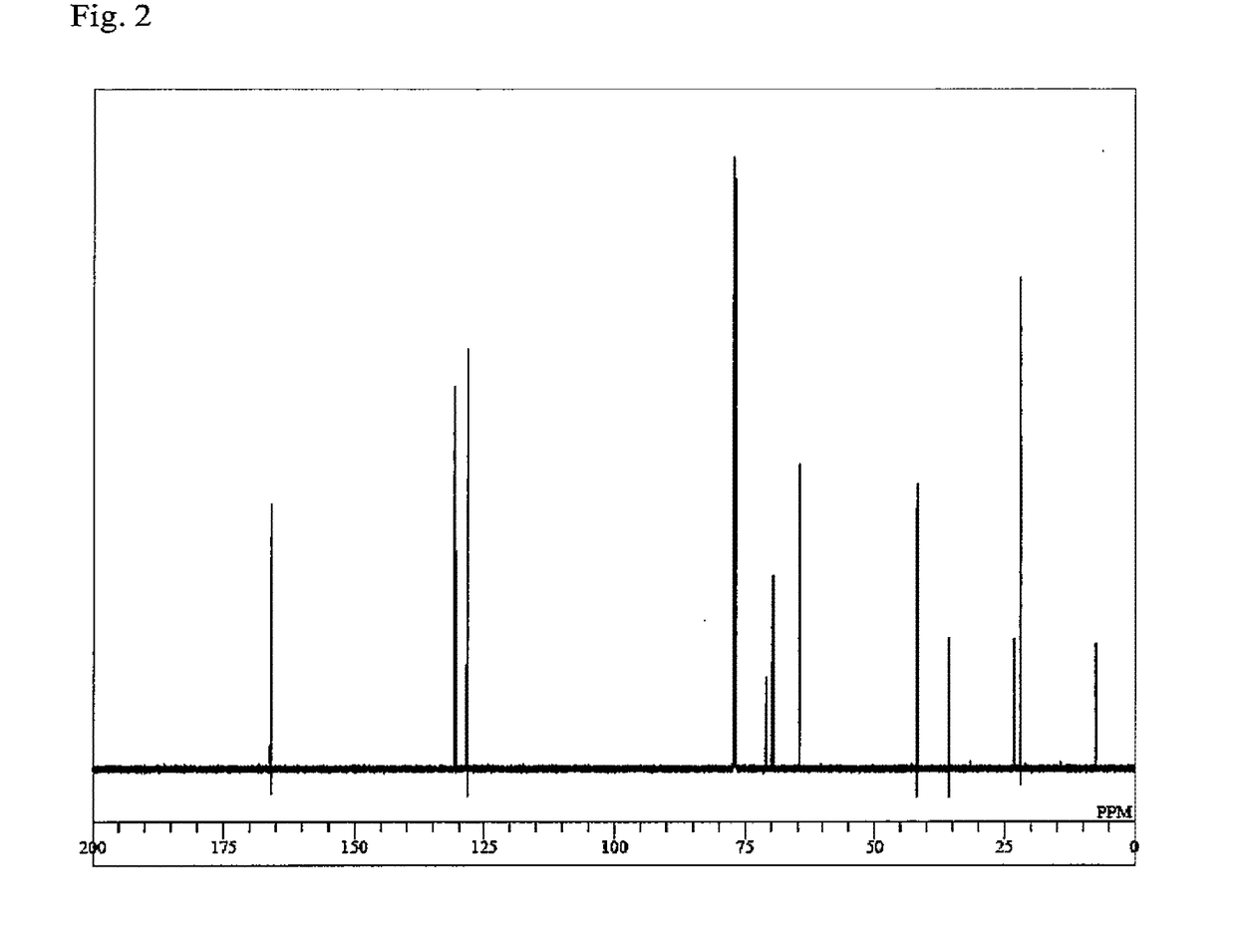Triacrylate compounds and methods for producing the same, and compositions
a technology of triacrylate and compounds, applied in the field of triacrylate compounds, can solve the problems of reducing curability or crosslinking density by the extension of chain length, reducing flexibility and curl, and high curing shrinkage, and achieves excellent balance of properties such as flex resistance and low curing shrinkage. , the effect of low curing shrinkag
- Summary
- Abstract
- Description
- Claims
- Application Information
AI Technical Summary
Benefits of technology
Problems solved by technology
Method used
Image
Examples
synthetic example 1
Synthesis of 2-(5-ethyl-5-hydroxymethyl-[1,3]dioxan-2-yl)-2-methylpropan-1-ol
[0104]A 2-liter round bottomed flask was loaded with 45.1 g of 2,2-dimethyl-3-hydroxypropionaldehyde (hydroxypivalaldehyde, manufactured by MITSUBISHI GAS CHEMICAL COMPANY, INC., purity 99.8%), 59.6 g of 2-ethyl-2-hydroxymethylpropane-1,3-diol (trimethylolpropane, reagent manufactured by Tokyo Chemical Industry Co., Ltd.), 706 g of benzene, and 5.0 g of granular Nafion (trade name “NR-50”, reagent manufactured by Sigma-Aldrich Co. LLC.). The reaction was performed at ordinary pressure while discharging byproduct water as an azeotrope with benzene out of the reaction system with use of a Dean-Stark trap until the distillation of water ceased. The product was filtered, concentrated and cooled to recrystallize. In this manner, a crystal of 2-(5-ethyl-5-hydroxymethyl-[1,3]dioxan-2-yl)-2-methylpropan-1-01 was obtained.
[0105]A catalyst for use in the hydrogenation of acetal was synthesized as follows.
Preparation ...
synthetic example 2
Synthesis of 2-ethyl-2-(3-hydroxy-2,2-dimethyl-propoxymethyl)-propane-1,3-diol
[0110]A 500 mL SUS reactor was loaded with 7.5 g of the catalyst A, 75 g of 2-(5-ethyl-5-hydroxymethyl-[1,3]dioxan-2-yl)-2-methylpropan-1-ol, and 225 g of dioxane. The reactor was then purged with nitrogen gas. Thereafter, 8.5 MPa hydrogen gas was fed into the reactor. The temperature was increased to a prescribed reaction temperature of 230° C., and the reaction was performed for 8 hours. After being cooled, the product in the reactor was recovered and recrystallized to give the target compound.
example 1
Synthesis of 2-((3-(acryloyloxy)-2,2-dimethylpropoxy)methyl)-2-ethylpropane-1,3-diyl diacrylate (NTTA)
[0111]In a glass reactor equipped with a stirring bar, a thermometer and a Vigreux column were mixed 2-ethyl-2-(3-hydroxy-2,2-dimethyl-propoxymethyl)-propane-1,3-diol (30.0 g, 136 mmol), methyl acrylate (59.3 g, 680 mmol), dimethyltin dichloride (900 mg, 4.1 mmol), sodium methoxide (216 mg, 4.1 mmol), p-methoxyphenol (297 mg, 2.4 mmol) and hydroquinone (120 mg, 1.1 mmol). The mixture was heated at an internal temperature of not less than 82° C. and not more than 94° C. While distilling off methanol from the system as an azeotrope with methyl acrylate, stirring was performed for 30 hours while performing heating. During the reaction, a 1 mass % p-methoxyphenol solution of methyl acrylate was added dropwise from the column top, thereby preventing polymerization in the Vigreux column and making up for the loss of methyl acrylate by azeotropic distillation of methanol. The catalyst and ...
PUM
| Property | Measurement | Unit |
|---|---|---|
| temperature | aaaaa | aaaaa |
| wavelength | aaaaa | aaaaa |
| thickness | aaaaa | aaaaa |
Abstract
Description
Claims
Application Information
 Login to View More
Login to View More - R&D
- Intellectual Property
- Life Sciences
- Materials
- Tech Scout
- Unparalleled Data Quality
- Higher Quality Content
- 60% Fewer Hallucinations
Browse by: Latest US Patents, China's latest patents, Technical Efficacy Thesaurus, Application Domain, Technology Topic, Popular Technical Reports.
© 2025 PatSnap. All rights reserved.Legal|Privacy policy|Modern Slavery Act Transparency Statement|Sitemap|About US| Contact US: help@patsnap.com



